No sooner does Samus land in the space station which comprises the entirety of Fusion‘s world than she comes across the first of many Navigation rooms. And that’s the beginning of the end for many people.
By far the most unpopular element of Fusion, the station’s Navigation rooms are compulsory stops where Samus has to stop and communicate with her mission “commander,” a computer which she nicknames Adam. (There’s a dumb plot twist around this later on, because the Metroid universe is incredibly tiny and basically consists of half a dozen named characters.) You can’t avoid these conversations, and they spell out every portion of your mission in excruciating detail until the point at which they don’t. For the first several hours of the game, Metroid Fusion offers very little sense of discovery as each and every goal is handed to you explicitly, not just through text but also with mini-map highlights as well.
On top of that, Adam is a patronizing, paternalistic, and sometimes condescending robot who talks to battle-hardened huntress Samus as if she couldn’t be trusted to visit a toilet unsupervised.
This marks a radical change in tone and style from previous Metroid games. Even at their most linear, the original Metroid trilogy dropped players into a silent labyrinth of space monsters and left them to their own devices. Not here. You’re marching to the orders of a computer, who sends you scurrying from point to point to do its grunt work: Investigate this, kill that, repair something else.
Mechanically, though, it’s very much Metroid. Samus runs and jumps, shoots, and finds her way through the space station maze. As soon as you receive your first mission objective from Adam, you come across this: The classic red door. Metroid veterans know the score here, of course. You can’t crack this door without a missile, which Samus doesn’t wield at this point. So regardless of how progress is doled out, there’ll still be opportunities to backtrack and navigate through previously inaccessible paths as you acquire new powers.
Speaking of new powers, Samus comes with one by default: The ability to grab on to ledges and pull herself up. This opens up a number of new puzzle design opportunities, but it ultimately comes from a place of practicality, an attempt to solve the Metroid II conundrum: Being on a portable system, Fusion suffers from diminished vertical pixel resolution compared to previous console entries (160 pixels versus 224). Metroid II’s solution to the Game Boy family’s scaled-down size was to make Samus bigger and then double down by giving her an infinite jump skill, often leading players to go leaping into danger without sufficient warning time.
Fusion goes the other route: It makes Samus’ sprite smaller than in Super Metroid, then diminishes the maximum height of her jump. Her reduced hang time makes for a faster-paced game, less floaty than earlier games. But the scale and proportions of the platforming remains similar to that of Super Metroid; Samus’ ability to grip ledges makes this possible. She can’t jump directly onto high platforms as in older games, but she can still reach those areas of the screen by pressing up against them and grabbing them. It’s a smart way to work around the platform’s inherent challenges while switching up the feel of the action and reinforcing the narrative conceit that Samus’ powers have been partially crippled.
The same shaft includes two other doors of a different color: Green, for Super Missiles. So multiple backtracks, then. The colored doors also mean that, for the moment, the game is strictly linear; there’s only one door you can go through, and it leads immediately to your objective.
Said objective is a small critter in a darkened room. This entire sequence, with Samus exploring a seemingly deserted space station, echoes Super Metroid‘s atmospheric beginning, but it’s far more brief, crashing to an abrupt ending here.
This encounter serves a much different purpose than Samus’ landing on Zebes in Super Metroid anyway; that involved a return to familiar territory and the slow build-up of tension. Here, you’re entering a never-before-seen locale in order to advance the story. The tension comes later.
Destroy the creature here and it spawns an X parasite, just like on SR388. This time, though, it doesn’t hurt Samus; instead, when Samus touches it — and the entrance to the room automatically locks and refuses to open until Samus makes contact with the parasite — she absorbs it harmlessly, taking it out of play.
As it turns out, Samus is now an X-destroying machine. Her metroid infusion allows her to soak up any class five full roaming vapors she may come across, converting them into life-sustaining energy and missile juice.
And here’s the central mechanical hook of Metroid Fusion. No longer do enemies drop standard energy and missile capsules; instead, a destroyed monster transforms into a free-flying parasite that can be absorbed to acquire similar effects to old-school capsules. But parasites have other traits as well, which changes the nature of certain areas of the game.
And here’s another change of pace: At key points in the story, Adam will unlock specific doors. This isn’t entirely without precedent, of course. Metroid II did something similar, with inexplicable earthquakes making new areas accessible as you worked your way through the metroid species. The similarity may not be an accident, as Metroid II informs much of Fusion‘s design.
The opening of Level 0 hatches allows Samus to travel beyond the very small entry areas.
You immediately meet another creature like the one in the darkened room. This one’s even easier to shoot, since it appears on a raised section of floor directly in Samus’ line of sight (you had to target diagonally or drop to the ground to shoot the first one). It’s your proper introduction to combat in Fusion, as the parasite this beast releases on its demise can be sucked up without incident or even ignored. A quick, simple, repeat encounter to denote the fact that you’ll be experiencing live combat from here on out.
And, with the introduction out of the way and combat encounters, you finally get to save. Just in case you screw up once the real monsters make their debut.
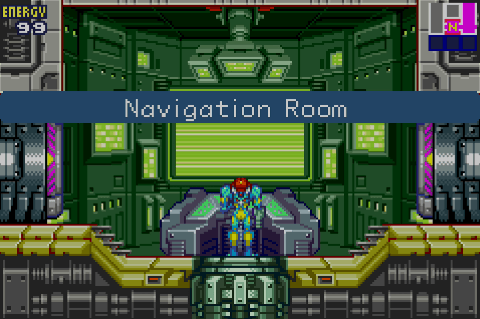
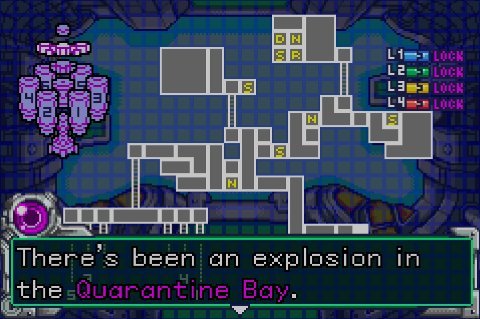
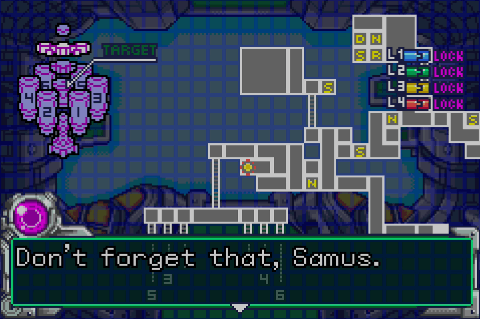

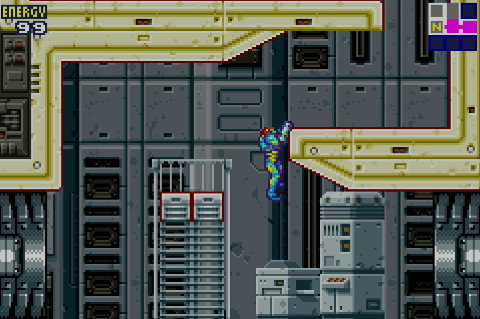
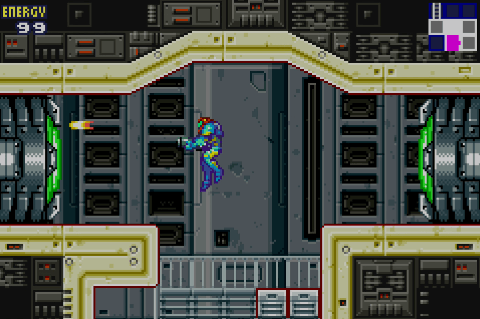
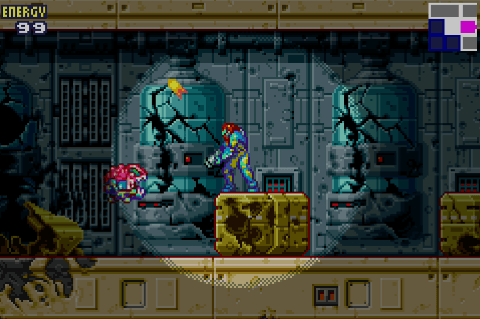
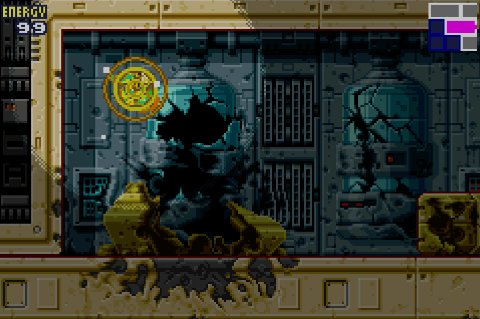
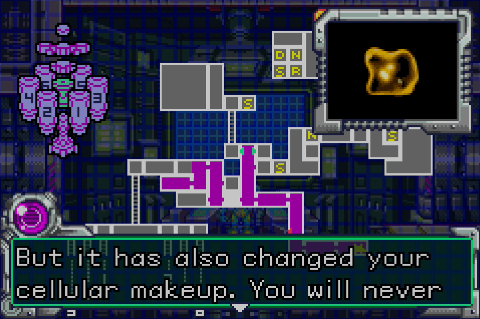
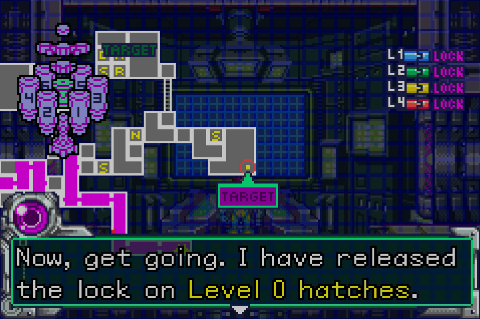
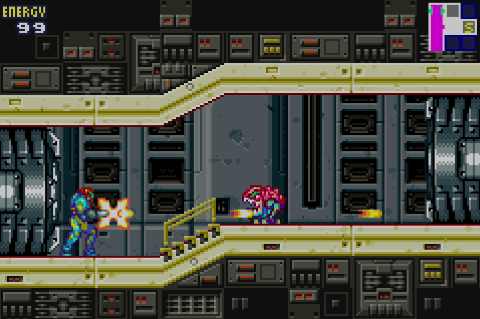
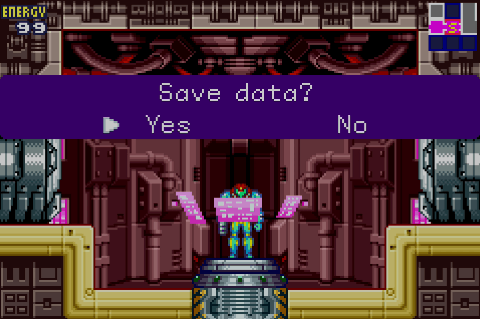
I played moste of this game while hiking up a mountain, because fuck beautiful sceenary I wanna play this game I can play literally anywhere.
Those navigation rooms were bulshit. I liked the game overall. I want to say that Samus’s original suit was an enemy too, and I like that idea.
Whoops, am I remembering wrong, or does Adam actually not unlock doors again in the game? You have to do that most of the time, but there might be one or two…
Adam unlocks a given set of security coded doors down in the environmental sectors. Outside those sectors, most are unlocked by weapons.
“More than that, Samus’ posture changes, with a ragged hunch to her stance that suggests weariness and fatigue.”
Thinking on this from the last entry, doesn’t she adopt the same posture throughout Zero Mission? Maybe it was more a way to reduce how much real estate she takes up on screen, as noted by mention of her reduced footprint above?
No, her “hunch” in ZM is just her suit’s shoulder… things. Whatever those are. She’s standing upright. In Fusion, she lacks the shoulder bulk and is hunched forward. In any case, it’s immaterial — ZM came after this, and Fusion marks a significant change in Samus’ appearance and posture.
Also, if you look carefully, in ZM (and other games) she aims by placing her off-hand on top of her arm cannon to steady it. In Fusion, her off-hand sits beneath her cannon, as if to hold it up — the only game in which she ever uses that firing stance. It’s an extremely subtle detail, but it’s there.
Looking back at the previous entry, she even uses the “hand on top” posture during the prologue when she’s in her old suit. God I love details like that, nicely spotted.
Hm, interesting. Though with regard to the part about ZM coming after, I wonder if that was carrying what you were saying about them making sure she appears smaller forward to the prequel, as they were on the same system.
And yeah, I see it now… pretty cool. I don’t think it ever occurred to me that she was really that much weaker here than her “normal” depowered state, so that’s something new I can appreciate about the game.
I used to think that, her varia suit was straight ripped from the SNES sprite. But after this post, I was curious to see if that was actually true, and well, it really wasnt. There is a chance that it was a rescaled and touched up sprite, but certain porportions seem to imply that at the very least many parts were redrawn. The difference you draw are more notorious when comparing Fusion suit vs the SA-X, and some of the noncombat poses.
SA-X is always fully erected and with the hand on top as you mention. The only time fusion samus seems fully erected is at save points and when using the Nav rooms. I used to think it was simply the same hunched samus improperly drawn or smth, until I realized that the sprite height differed on those poses by a few pixels. I drew the conclusion then that the hunching need lies on supporting her hand cannon.
I think too much is made of the “hunched over” posture, really. To me, it’s never seemed like the hunch was because she was weary, weaker, or any of that. It always seemed to me to be a more feral pose: she’s part metroid now, and metroids are hunters. Samus was a hunter before, but now it’s literally in her DNA, and it’s something done on purpose. She’s lowering her center of gravity to be more agile on her feet, and to make breaking into a run less awkward-something that’s important when your armor is as weak as the fusion suit is. Think about the posture of soldiers in the jungle-they’re hunched over a little, only standing at full height when basically at rest. Low down, ready to fight: that’s what I get from the posture.
Everyone’s welcome to their own interpretation of stuff like this! Still, I think that reading stands in direct contradiction to pretty much the entire rest of the game.